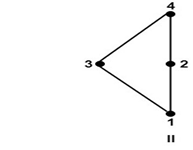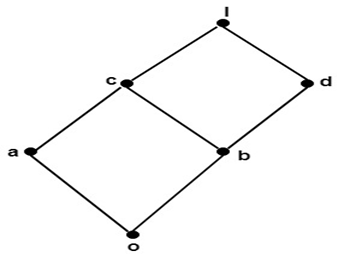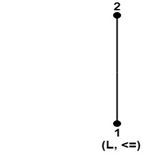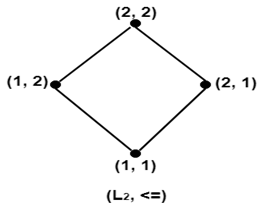Let L be a non-empty set closed under two binary operations called meet and join, denoted by ∧ and ∨. Then L is called a lattice if the following axioms hold where a, b, c are elements in L:
1) Commutative Law: -
(a) a ∧ b = b ∧ a (b) a ∨ b = b ∨ a
2) Associative Law:-
(a) (a ∧ b)∧ c = a ∧(b∧ c) (b) (a ∨ b) ∨ c = a ∨ (b ∨ c)
3) Absorption Law: -
(a) a ∧ ( a ∨ b) = a (b) a ∨ ( a ∧ b) = a
Duality:
The dual of any statement in a lattice (L,∧ ,∨ ) is defined to be a statement that is obtained by interchanging ∧ an ∨.
For example, the dual of a ∧ (b ∨ a) = a ∨ a is a ∨ (b ∧ a )= a ∧ a
Bounded Lattices:
A lattice L is called a bounded lattice if it has greatest element 1 and a least element 0.
Example:
- The power set P(S) of the set S under the operations of intersection and union is a bounded lattice since ∅ is the least element of P(S) and the set S is the greatest element of P(S).
- The set of +ve integer I+ under the usual order of ≤ is not a bounded lattice since it has a least element 1 but the greatest element does not exist.
Properties of Bounded Lattices:
If L is a bounded lattice, then for any element a ∈ L, we have the following identities:
- a ∨ 1 = 1
- a ∧1= a
- a ∨0=a
- a ∧0=0
Theorem: Prove that every finite lattice L = {a1,a2,a3....an} is bounded.
Proof: We have given the finite lattice:
L = {a1,a2,a3....an}
Thus, the greatest element of Lattices L is a1∨ a2∨ a3∨....∨an.
Also, the least element of lattice L is a1∧ a2∧a3∧....∧an.
Since, the greatest and least elements exist for every finite lattice. Hence, L is bounded.
Sub-Lattices:
Consider a non-empty subset L1 of a lattice L. Then L1 is called a sub-lattice of L if L1 itself is a lattice i.e., the operation of L i.e., a ∨ b ∈ L1 and a ∧ b ∈ L1 whenever a ∈ L1 and b ∈ L1.
Example: Consider the lattice of all +ve integers I+ under the operation of divisibility. The lattice Dn of all divisors of n > 1 is a sub-lattice of I+.
Determine all the sub-lattices of D30 that contain at least four elements, D30={1,2,3,5,6,10,15,30}.
Solution: The sub-lattices of D30 that contain at least four elements are as follows:
1. {1, 2, 6, 30} 2. {1, 2, 3, 30}
3. {1, 5, 15, 30} 4. {1, 3, 6, 30}
5. {1, 5, 10, 30} 6. {1, 3, 15, 30}
7. {2, 6, 10, 30}
Isomorphic Lattices:
Two lattices L1 and L2 are called isomorphic lattices if there is a bijection from L1 to L2 i.e., f: L1⟶ L2, such that f (a ∧ b) =f(a)∧ f(b) and f (a ∨ b) = f (a) ∨ f (b)
Example: Determine whether the lattices shown in fig are isomorphic.
Solution: The lattices shown in fig are isomorphic. Consider the mapping f = {(a, 1), (b, 2), (c, 3), (d, 4)}.For example f (b ∧ c) = f (a) = 1. Also, we have f (b) ∧ f(c) = 2 ∧ 3 = 1

Distributive Lattice:
A lattice L is called distributive lattice if for any elements a, b and c of L,it satisfies following distributive properties:
- a ∧ (b ∨ c) = (a ∧ b) ∨ (a ∧ c)
- a ∨ (b ∧ c) = (a ∨ b) ∧ (a ∨ c)
If the lattice L does not satisfies the above properties, it is called a non-distributive lattice.
Example:
- The power set P (S) of the set S under the operation of intersection and union is a distributive function. Since,
a ∩ (b ∪ c) = (a ∩ b) ∪ (a ∩ c)
and, also a ∪ (b ∩ c) = (a ∪ b) ∩ (a ∪c) for any sets a, b and c of P(S). - The lattice shown in fig II is a distributive. Since, it satisfies the distributive properties for all ordered triples which are taken from 1, 2, 3, and 4.

Complements and complemented lattices:
Let L be a bounded lattice with lower bound o and upper bound I. Let a be an element if L. An element x in L is called a complement of a if a ∨ x = I and a ∧ x = 0
A lattice L is said to be complemented if L is bounded and every element in L has a complement.
Example: Determine the complement of a and c in fig:

Solution: The complement of a is d. Since, a ∨ d = 1 and a ∧ d = 0
The complement of c does not exist. Since, there does not exist any element c such that c ∨ c'=1 and c ∧ c'= 0.
Modular Lattice:
A lattice (L, ∧,∨) is called a modular lattice if a ∨ (b ∧ c) = (a ∨ b) ∧ c whenever a ≤ c.
Direct Product of Lattices:
Let (L1 ∨1 ∧1)and (L2 ∨2 ∧2) be two lattices. Then (L, ∧,∨) is the direct product of lattices, where L = L1 x L2 in which the binary operation ∨(join) and ∧(meet) on L are such that for any (a1,b1)and (a2,b2) in L.
(a1,b1)∨( a2,b2 )=(a1 ∨1 a2,b1 ∨2 b2)
and (a1,b1) ∧ ( a2,b2 )=(a1 ∧1 a2,b1 ∧2 b2).
Example: Consider a lattice (L, ≤) as shown in fig. where L = {1, 2}. Determine the lattices (L2, ≤), where L2=L x L.

Solution: The lattice (L2, ≤) is shown in fig:





No comments:
Post a Comment